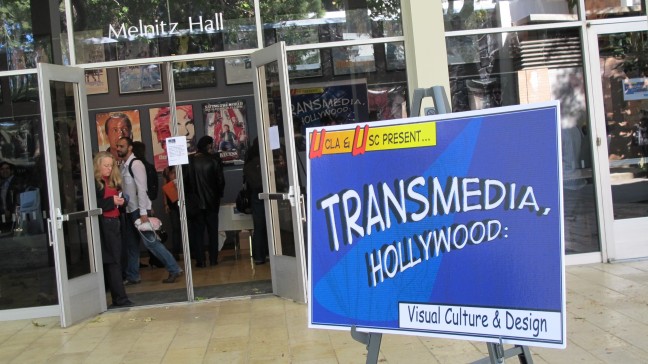Transmedia storytelling: transforming the media industry

The entrance to the seminar "Transmedia, Hollywood" in the University of California, Los Angeles
Our current multi-channel, multi-screen, “always on” world is giving rise to a new form of storytelling, “transmedia”, in which a narrative unfolds across multiple forms of media. University of California, Los Angeles (UCLA) will hold a symposium on “Transmedia, Hollywood” on April 12th, reflecting the popularity of research on transmedia in communications departments.
Professor Henry Jenkins, a well-known transmedia scholar at the University of Southern California, gave a definition of the communications phenomenon: “Transmedia storytelling represents a process where integral elements of a fiction get dispersed systematically across multiple delivery channels for the purpose of creating a unified and coordinated entertainment experience. Ideally, each medium makes it own unique contribution to the unfolding of the story.” Henry pointed out that the 1999 film The Matrix is a good example showcasing a classic use of transmedia storytelling techniques. In The Matrix, elements of the story are systematically dispersed across the films, a series of animated short films, two sets of comic strips and several games. To understand the full background of the story, the audience must integrate pieces of the narrative from all of these media sources. This is transmedia storytelling.
In his book Convergence Culture, Henry Jenkins articulates a new paradigm for thinking about the current moment of media change through the layering, diversification, and interconnectivity of media. Convergence contrasts with the Digital Revolution model, which assumed that old media would be displaced by new media. Aspects of this ongoing convergence model are shaping the decisions of media producers, advertisers, technologists, consumers, and policy-makers, and thus convergence has many different aspects and consequences.
Transmedia is often misunderstood, Andrea Philips, an American game designer pointed out. For instance, the Smurfs—Smurfs movies, a Smurfs animated series, lunch boxes, plush animals and so on—are not building up to a single narrative thread that becomes stronger when the viewer sees all of the pieces. Andrea differentiated this reappearance of content and story on multiple platforms but without a transcendent narrative as cross-media instead of transmedia.
Henry defined a movement across texts or across textual structures within the same medium as “intertextuality”. For example, Battlestar Galactica unfolds across multiple television series, mini-series, and stand-alone movies. If it remained in a single medium, for instance television, then it would be another example of intertextuality. But Battlestar Gallactica extends this process to include webisodes and comics, which are understood as part of the same continuity, making it a transmedia story rather than an intertextual story.
In fact, transmedia storytelling is not only largely applied in the cultural industry, but also can be found in other fields. Henry argued that U.S. President Barack Obama is an example of a transmedia character. Though for the vast majority everyday life is now conducted across multiple media platforms, people tend to connect dispersed pieces of information from these different media sources together to form a single story. That story depends on which media extensions people draw upon (Fox News vs. The Huffingston Post), and there are architects who seek to coordinate and construct the range of meanings that get attached to that story. In that sense, Henry explained, the Obama story that was constructed by his campaign includes both intertextuality and multimodality (different media involving different kinds of representation).
While the scope of transmedia may make it seem like something only Hollywood and big networks have the resources to pull off, Henry adamantly disagreed with this notion, pointing out that Lance Weiller, who makes mostly low budget horror projects in the spirit of William Castle, has probably thought as deeply and performed as imaginatively in transmedia as anyone working for Hollywood. Independent artists often have more creative control to be able to pursue their imagination across media and to create richer, more fully integrated experiences. Therefore, the application of transmedia might have the potential to change current patterns in the media industry.
The Chinese version appeared in Chinese Social Sciences Today, No. 434, Apr. 1, 2013
Edited by Zhang Mengying
